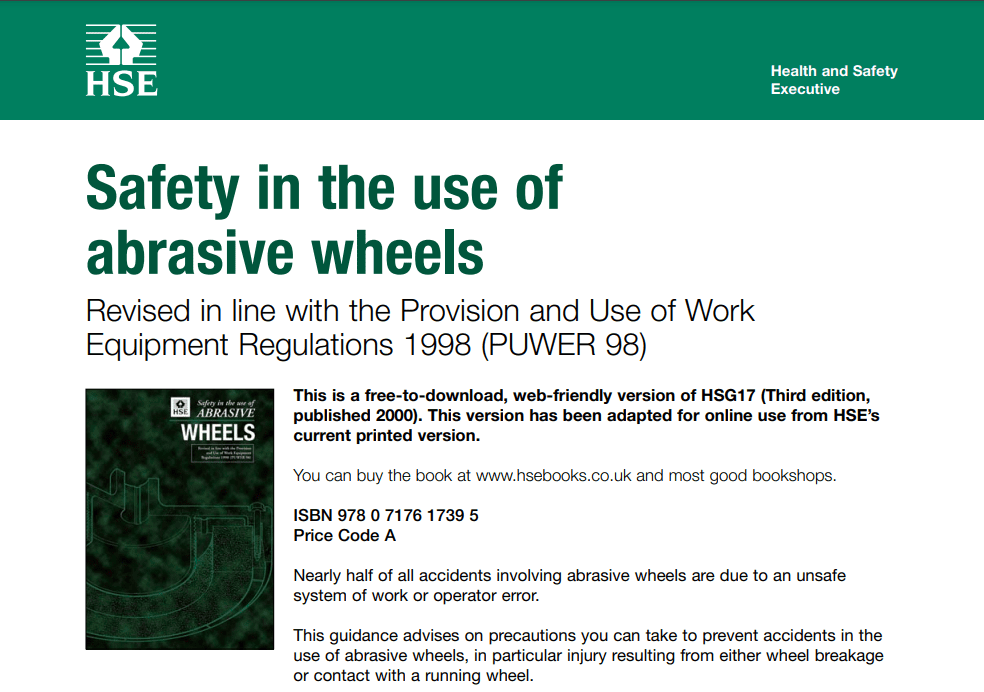
19 Sep HSG17 Safety in the Use of Abrasive Wheels
What is HSG17
HSG17 is the Health and Safety Executive (HSE) guidance document, safety in the use of abrasive wheels. Is this guidance relevant to you? This guidance is relevant to anyone who uses or mounts abrasive wheels and also the managers of these people. Revised in line with the Provision and Use of Work Equipment Regulations 1998 (PUWER 98) HSG17 provides a comprehensive guide. Nearly half of all accidents involving abrasive wheels are due to an unsafe system of work or operator error.
What does HSG17 cover?
The purpose of HSG17 safety in the use of abrasive wheels is to give advice on precautions for the prevention of accidents in the use of abrasive wheels, in particular injury resulting from either wheel breakage or contact with a running wheel.
The 53 page document covers:
- Training
- Abrasive wheel characteristics
- Safety
- The grinding machine
- Mounting of abrasive wheels
- Summary of mounting procedures
- Guards
- Portable and hand-held grinding machines
- Operation of abrasive wheels
- Summary of operating precautions
- Personal protective equipment
- Tables
- References and further reading
Abrasive Wheel Training
Covered early on in the HSG17 safety in the use of abrasive wheels guidance, is the training element. The HSE states: There is no substitute for thorough practical training in all aspects of the mounting and use of abrasive wheels.
This means that when you are looking for abrasive wheel training courses, you need to specifically look for face to face training. There is no substitute for this. In line with HSG 17 online training would not be thorough enough. Our experienced training team have developed a package of over 14 different training courses, covering every type of abrasive wheel equipment. This means that not only is the training thorough but it is appropriate for the equipment that you use. The guidance sets out 9 points that any training should cover. The British Abrasives Federation are named as the organisation to find out more details about training. All our trainers are accredited by the BAF to train in all types of abrasive wheels.
Abrasive Wheel Characteristics
An abrasive wheel is usually defined as a wheel consisting of abrasive particles bonded together with various substances. There are two main types of bonding agent: inorganic and organic. This section of the guidance discuss the characteristics and abrasive wheel marking system in more detail.
Safety
Abrasive wheel manufacturers take all reasonable precautions, including speed tests, to supply sound wheels, and various methods are used in their construction to reduce the risk of breakage. HSG17 safety section covers wheel breakage, examination, handling, storage and more.
The Grinding Machine
Abrasive wheels should not be mounted on makeshift apparatus. They should be mounted on the type of machine for which they are intended. This area of the guidance covers the grinding machine in more detail.
Mounting of Abrasive Wheels
The danger of an abrasive wheel bursting is considerably increased if it is not properly mounted; many accidents could be prevented if the people mounting the wheels were instructed. Therefore this guidance document covers this subject in more detail.
Summary of Mounting Procedures
This section of HSG17 states:
Wheel mounting should be carried out only by an appropriately trained person. A wheel should be mounted only on the machine for which it was intended. Before mounting, all wheels should be closely inspected. This is to ensure that they have not been damaged in storage or transit.
This section in the guidance provides further detailed information on this subject.
Guards
This section of the guidance covers the purpose of guards in detail, through the use of diagrams and additional information.
Portable and Hand-Held Grinding Machines
The largest number of abrasive wheels used are those found on hand-held machines. In fact, these machines are often used by people who have a wide range of skills, from the domestic user to the skilled tradesman, with the predominant user being semi-skilled. Therefore this area of the guidance is probably the most relevant to abrasive wheel equipment used today. This part of HSG17 covers various topics including types of machine and inspection and maintenance.
Operation of Abrasive Wheels
While the guidance covers the operation of abrasive wheels, it states in more detail: truing and dressing, wheel balance, side grinding, grinding fluids, grinding of magnesium alloys and additional protection.
Summary of Operating Precautions
This section of the guidance states: Given an abrasive wheel of sound manufacture, mounted on a well-designed machine, safe operation depends largely on proper maintenance and on the treatment to which the wheel is subjected when in use. It then lists the main operating precautions to consider.
Personal Protective Equipment
To comply with the Personal Protective Equipment Regulations 199217 and other regulations, for example the Control of Substances Hazardous to Health Regulations18 and the Control of Noise at Work Regulations 2005,19 appropriate protection must be worn. The HSG17 guidance advises on the PPE required.
Tables
This particular section lists machine types, wheels and speeds. For that reason, this section provides a useful guide for anyone using abrasive wheel equipment.
References and Further Reading
This comprehensive guide provides a large amount of information relating to safety in the use of abrasive wheels. There is also a reference section giving further details of reference documents and a guide to further suitable reading.
Download HSG17
Want to learn more? You can download your free PDF copy of HSG17 safety in the use of abrasive wheels here.
Contact Us
For the most part, HSG17 provides a comprehensive guide. However, this does not replace the need for training. For more help or information relating to abrasive wheel training please contact our helpful team who will be happy to help.



No Comments